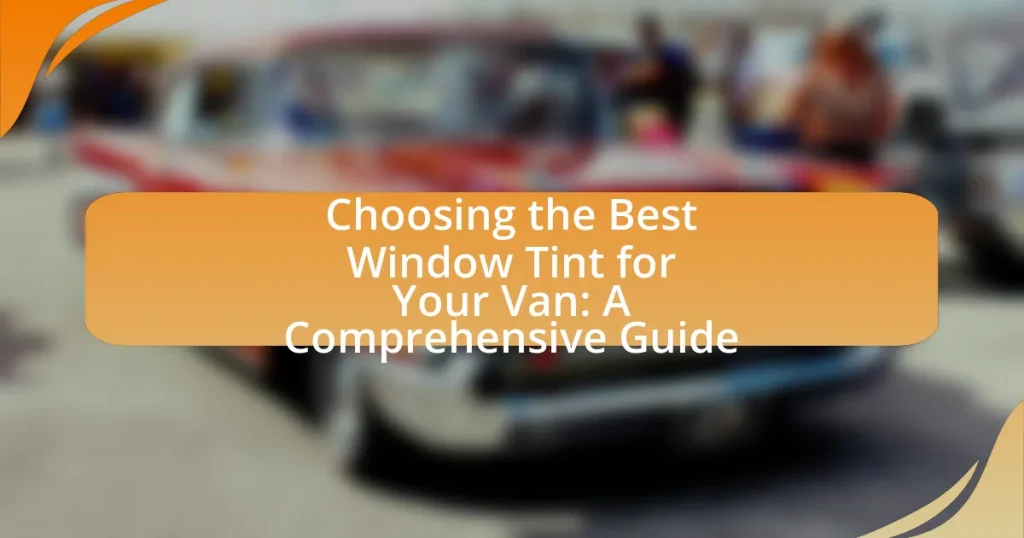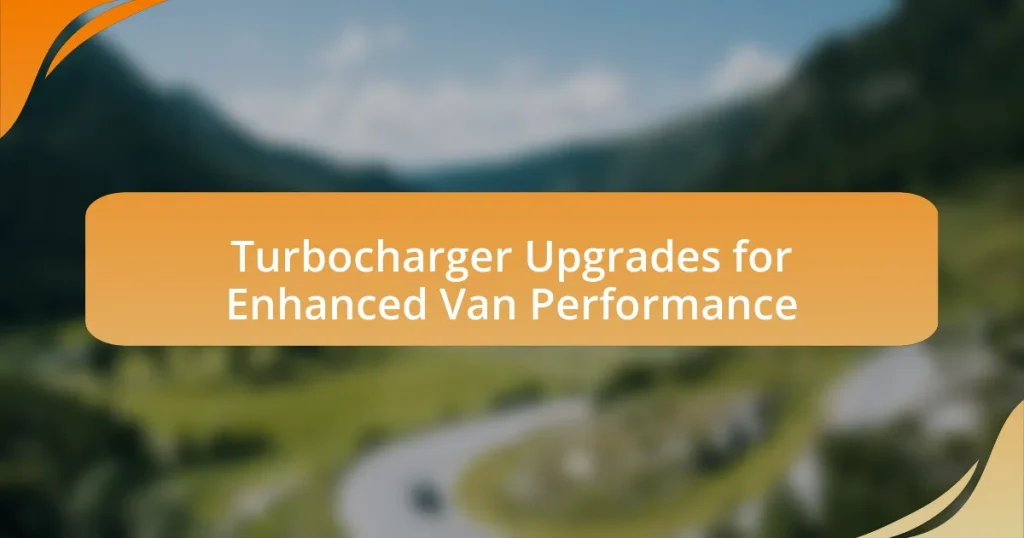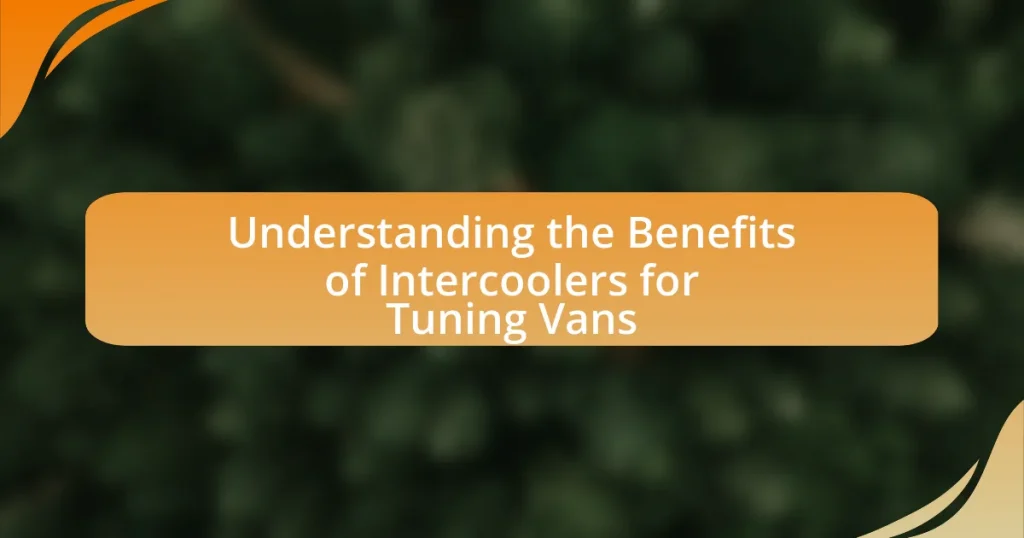The article focuses on selecting the best window tint for vans, emphasizing the importance of legal regulations, tint materials, and installation quality. It outlines the various types of window tinting films, including dyed, metalized, ceramic, and hybrid options, detailing their benefits in terms of UV protection, heat rejection, and durability. Additionally, the article discusses factors influencing tint choice, such as climate, budget, and aesthetic preferences, while providing guidance on installation practices and maintenance tips to ensure longevity and effectiveness. Key considerations include compliance with local laws, the impact of tint on visibility and comfort, and the potential for long-term savings associated with higher-quality films.
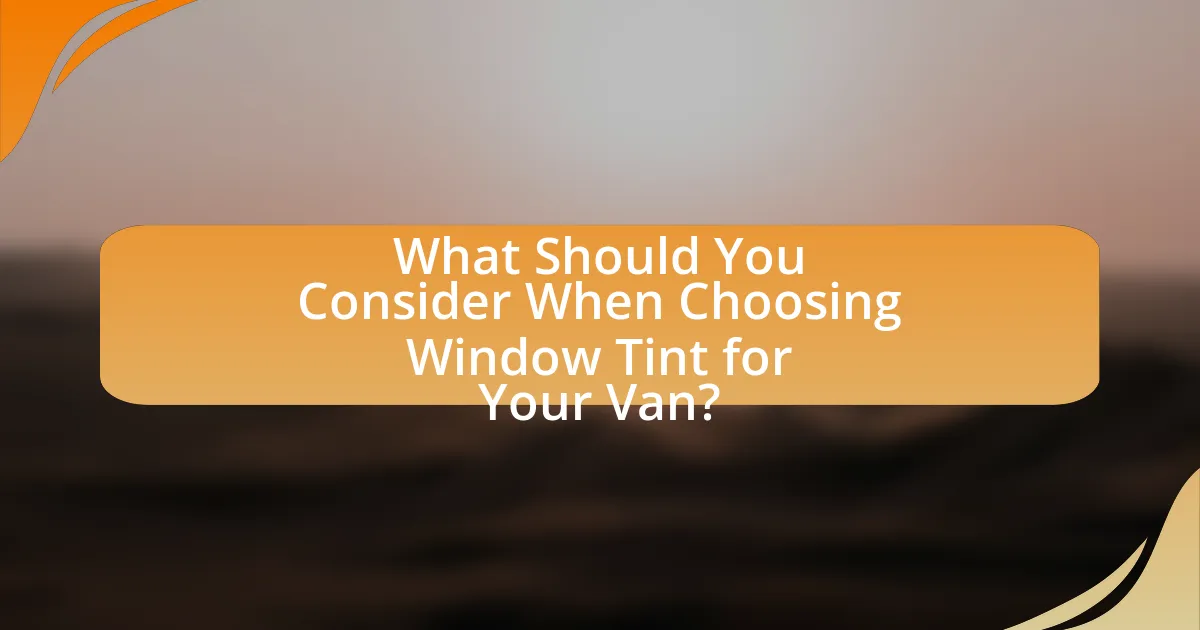
What Should You Consider When Choosing Window Tint for Your Van?
When choosing window tint for your van, consider the legal regulations regarding tint darkness and reflectivity in your area. Different states have specific laws that dictate how dark or reflective window tint can be, which can affect your decision. Additionally, evaluate the type of tint material, such as dyed, metalized, or ceramic, as each offers varying levels of heat rejection, UV protection, and durability. For instance, ceramic tints provide superior heat rejection and UV protection without interfering with electronic devices. Lastly, consider the warranty and installation quality, as professional installation can ensure longevity and effectiveness of the tint.
How Does Window Tinting Work?
Window tinting works by applying a thin film to the glass surface, which alters the way light interacts with the window. This film can reflect, absorb, or transmit varying amounts of light and heat, depending on its composition and thickness. For instance, films made from materials like polyester or ceramic can block up to 99% of harmful UV rays, reducing heat buildup inside the vehicle and protecting interior materials from fading. Additionally, window tinting can enhance privacy and security by making it more difficult to see inside the vehicle.
What are the different types of window tinting films available?
The different types of window tinting films available include dyed, metalized, ceramic, and hybrid films. Dyed films provide privacy and reduce glare but do not offer significant heat rejection. Metalized films contain tiny metallic particles that reflect heat and UV rays, enhancing durability and privacy. Ceramic films utilize advanced technology to block heat and UV rays without interfering with electronic signals, making them highly effective. Hybrid films combine elements of dyed and metalized films, offering a balance of heat rejection and aesthetic appeal. Each type serves specific needs, such as privacy, heat reduction, and UV protection, making them suitable for various applications.
How does the tinting process affect visibility and heat reduction?
The tinting process reduces visibility by darkening windows, which can limit the amount of light that enters a vehicle. This reduction in light can enhance privacy and reduce glare but may also make it harder to see outside, especially at night or in low-light conditions. Additionally, window tinting significantly decreases heat by blocking a substantial percentage of solar energy; high-quality tints can reject up to 99% of harmful UV rays and reduce interior temperatures by as much as 60%. This heat reduction is achieved through the use of specialized materials that reflect or absorb solar radiation, making vehicles more comfortable and energy-efficient.
What are the Benefits of Window Tinting for Vans?
Window tinting for vans provides several benefits, including enhanced privacy, UV protection, and temperature regulation. Enhanced privacy is achieved through darker window films, which prevent outsiders from easily seeing inside the vehicle. UV protection is significant, as window tint can block up to 99% of harmful ultraviolet rays, reducing the risk of skin damage and protecting the interior from fading. Additionally, temperature regulation is improved because window tint reflects solar heat, leading to a cooler interior and reduced reliance on air conditioning, which can enhance fuel efficiency. These benefits collectively contribute to a more comfortable and safer driving experience.
How does window tinting enhance privacy and security?
Window tinting enhances privacy and security by limiting visibility into the vehicle while allowing occupants to see out. This reduction in transparency deters potential intruders, as they cannot easily assess the contents or occupants of the van. Additionally, window tinting can provide a layer of protection against UV rays and heat, which contributes to the overall safety and comfort of the vehicle’s interior. Studies indicate that darker tints can reduce glare and improve driving visibility, further enhancing safety.
What impact does window tinting have on UV protection and interior preservation?
Window tinting significantly enhances UV protection and interior preservation. Specifically, high-quality window films can block up to 99% of harmful ultraviolet rays, which helps prevent skin damage and reduces the risk of skin cancer. Additionally, by blocking UV rays, window tinting protects interior materials from fading and deterioration, thereby extending the lifespan of upholstery, dashboards, and other surfaces. Studies indicate that prolonged exposure to UV radiation can lead to significant interior damage, making window tinting an effective solution for maintaining the aesthetic and functional quality of a vehicle’s interior.
What Legal Considerations Should You Be Aware of When Tinting Your Van?
When tinting your van, you must be aware of local laws regarding window tinting regulations, which vary by state or country. These regulations typically specify the allowable levels of visible light transmission (VLT) for different windows, including front, rear, and side windows. For example, many jurisdictions require that the front windshield allows at least 70% of light to pass through, while rear windows may have more lenient restrictions. Additionally, some areas prohibit certain tint colors or reflective materials. Non-compliance with these laws can result in fines, mandatory removal of the tint, or vehicle inspections. Therefore, it is essential to consult local vehicle codes or regulations to ensure that your van’s tinting meets legal standards.
What are the regulations regarding window tint darkness in different states?
Window tint darkness regulations vary by state, with specific limits on the percentage of visible light transmission (VLT) allowed. For example, in California, the front windshield must allow more than 70% VLT, while the front side windows must also meet this requirement. In contrast, states like New Jersey permit only 70% VLT for front side windows but allow darker tints on rear windows. Each state has its own set of rules, often influenced by safety and visibility concerns, which can be verified through state vehicle codes or department of motor vehicle guidelines.
How can you ensure compliance with local laws when choosing window tint?
To ensure compliance with local laws when choosing window tint, first, research the specific regulations in your area regarding tint darkness and reflectivity. Many states and municipalities have established legal limits on how dark window tint can be, as well as restrictions on reflective materials. For example, in California, the front windshield must allow more than 70% of light in, while the rear windows can be tinted darker. Additionally, consult local law enforcement or the Department of Motor Vehicles for guidance on acceptable tint specifications. This approach guarantees that the chosen window tint adheres to legal standards, preventing potential fines or the need for removal.
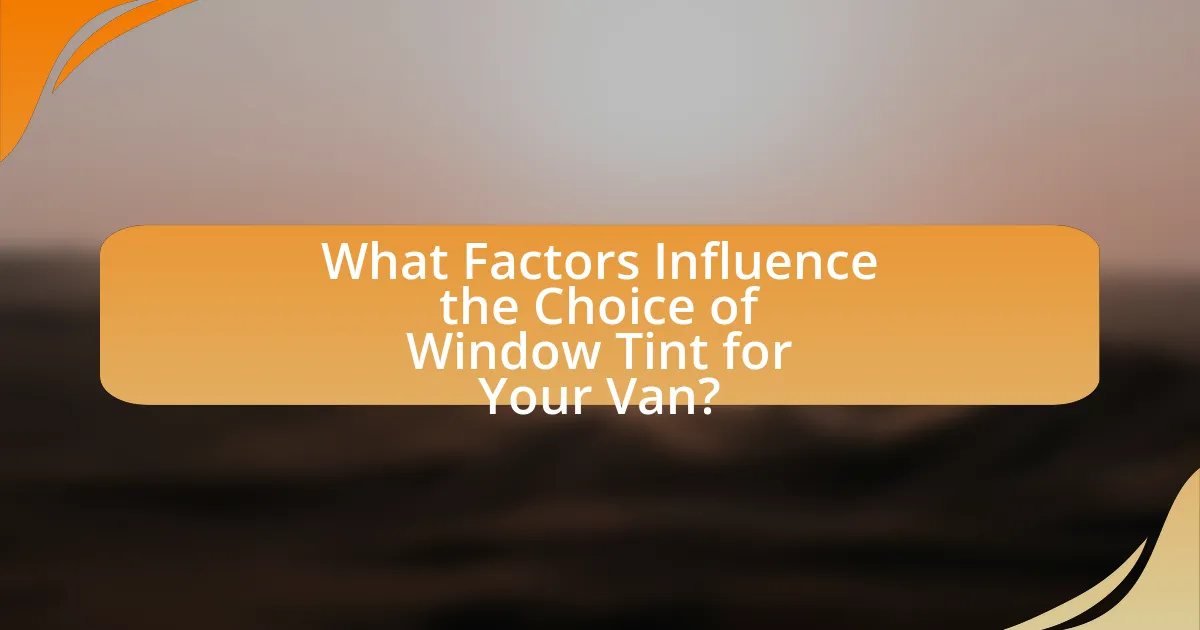
What Factors Influence the Choice of Window Tint for Your Van?
The choice of window tint for your van is influenced by factors such as legal regulations, heat rejection properties, UV protection, aesthetic preferences, and the type of tint material. Legal regulations vary by state or country, dictating the allowable tint darkness and reflectivity, which must be adhered to for compliance. Heat rejection properties are crucial for enhancing comfort and reducing energy costs, with higher-quality tints offering better insulation. UV protection is essential for safeguarding passengers and interior materials from harmful rays, with many tints blocking up to 99% of UV radiation. Aesthetic preferences play a role in selecting a tint that complements the van’s appearance, while the type of tint material—such as dyed, metalized, or ceramic—affects durability, performance, and cost. These factors collectively guide the decision-making process for selecting the most suitable window tint for a van.
How Do Climate and Environment Affect Your Tint Selection?
Climate and environment significantly influence tint selection by determining the level of heat and UV protection required. For instance, in hotter climates, darker tints are often preferred as they provide better heat rejection, reducing interior temperatures and enhancing comfort. Conversely, in cooler climates, lighter tints may be chosen to allow more sunlight and warmth into the vehicle. Additionally, areas with high UV exposure necessitate tints with higher UV protection ratings to safeguard against skin damage and interior fading. Research indicates that window films can block up to 99% of harmful UV rays, making them essential in sunny environments. Therefore, understanding local climate conditions and environmental factors is crucial for selecting the most effective window tint for a van.
What types of tint are best for hot climates?
Ceramic window tints are the best option for hot climates due to their superior heat rejection properties. These tints can block up to 99% of harmful UV rays and significantly reduce solar heat gain, making them ideal for maintaining a cooler interior temperature in vehicles. Additionally, ceramic tints do not interfere with electronic signals, which is beneficial for modern vehicles equipped with various technologies. Studies have shown that ceramic tints can lower interior temperatures by as much as 30%, providing both comfort and energy efficiency in hot weather conditions.
How does the local environment influence the durability of window tint?
The local environment significantly influences the durability of window tint by exposing it to varying levels of UV radiation, temperature fluctuations, and humidity. High UV exposure can degrade the adhesive and film material, leading to fading and peeling, while extreme temperature changes can cause the tint to expand and contract, potentially resulting in cracks or bubbles. Additionally, areas with high humidity can promote mold growth between the tint and glass, further compromising its integrity. Studies show that window tints installed in regions with intense sunlight and heat, such as desert climates, tend to have shorter lifespans compared to those in milder environments.
What is Your Budget for Window Tinting?
The budget for window tinting typically ranges from $100 to $400, depending on the type of tint and the size of the vehicle. Factors influencing this budget include the quality of the film, the complexity of the installation, and the geographic location of the service provider. For example, high-quality ceramic tints can cost more, often exceeding $500, while basic dyed films are on the lower end of the spectrum.
How do different types of window tint vary in cost?
Different types of window tint vary in cost primarily based on the materials used and the level of heat rejection they provide. For instance, dyed window tint typically costs between $100 to $400 for a full vehicle installation, while metalized tint ranges from $200 to $600 due to its enhanced durability and heat rejection properties. Ceramic window tint, known for its superior performance and UV protection, can range from $400 to $800, reflecting its advanced technology and effectiveness. These price ranges are influenced by factors such as brand reputation, installation complexity, and regional market differences.
What are the long-term savings associated with investing in higher-quality tint?
Investing in higher-quality tint can lead to significant long-term savings primarily through energy efficiency and reduced maintenance costs. Higher-quality window tints often provide better insulation, which can lower heating and cooling expenses by up to 30%, as they effectively block UV rays and reduce heat gain. Additionally, these tints tend to have a longer lifespan, often lasting over a decade without fading or peeling, which minimizes the need for replacement and associated costs. This durability translates into fewer expenditures on reapplication or repairs, further enhancing overall savings.
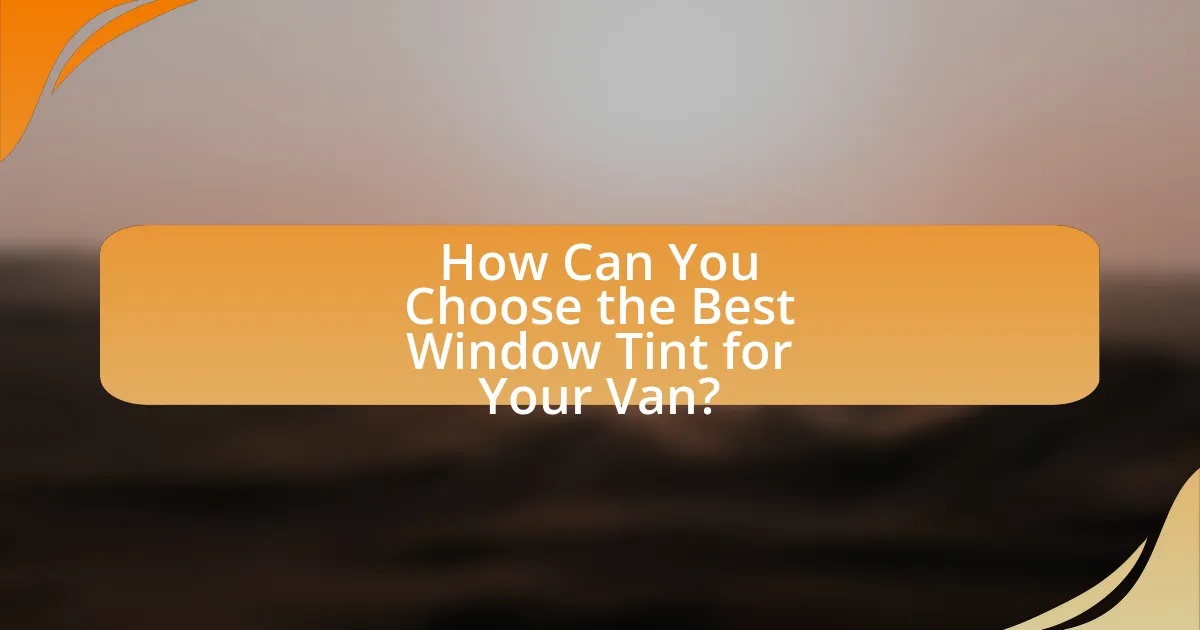
How Can You Choose the Best Window Tint for Your Van?
To choose the best window tint for your van, assess the tint’s UV protection, heat rejection, and visibility levels. High-quality window tints can block up to 99% of harmful UV rays, significantly reducing skin damage and interior fading. Additionally, consider the heat rejection capabilities, as some tints can lower interior temperatures by up to 60%, enhancing comfort and reducing air conditioning costs. Finally, ensure the tint complies with local regulations regarding visible light transmission, as laws vary by state and can affect your choice.
What are the Key Features to Look for in Window Tint?
The key features to look for in window tint include UV protection, heat rejection, glare reduction, and durability. UV protection is essential as it blocks harmful ultraviolet rays, reducing skin cancer risk and protecting interior materials from fading. Heat rejection capabilities help maintain a cooler interior temperature, enhancing comfort and reducing air conditioning costs. Glare reduction improves visibility and driving safety by minimizing sun glare. Durability ensures the tint withstands wear and tear, maintaining its appearance and effectiveness over time. High-quality window tints often come with warranties, further indicating their reliability and performance.
How do you assess the quality of window tint films?
To assess the quality of window tint films, examine factors such as UV protection, heat rejection, visible light transmission, and durability. High-quality films typically block up to 99% of harmful UV rays, significantly reducing skin damage and interior fading. Additionally, effective heat rejection can lower vehicle interior temperatures by up to 60%, enhancing comfort and energy efficiency. The visible light transmission percentage indicates how much light passes through the film; quality films usually offer a balance between privacy and visibility. Lastly, durability is crucial; premium films resist bubbling, peeling, and discoloration, often backed by warranties of 5 to 10 years.
What warranties or guarantees should you expect from tint providers?
When selecting tint providers, you should expect warranties or guarantees that typically cover the film’s durability, fading, and bubbling. Most reputable tint providers offer a limited lifetime warranty, ensuring that the tint will not peel, crack, or fade under normal conditions. Additionally, some providers may guarantee against manufacturer defects for a specific period, often ranging from five to ten years. These warranties are crucial as they provide assurance of the product’s quality and longevity, reflecting industry standards where many leading brands, such as 3M and Llumar, back their products with comprehensive warranties.
What are the Best Practices for Installing Window Tint?
The best practices for installing window tint include thorough surface preparation, precise measurement, and careful application techniques. First, clean the windows with a solution that removes dirt, grease, and residues to ensure proper adhesion of the tint film. Next, measure the windows accurately to cut the tint film to the correct size, allowing for slight overlaps to ensure complete coverage. During application, use a squeegee to eliminate air bubbles and ensure a smooth finish, applying the tint from the center outward. Additionally, allow the tint to cure for the recommended time, typically 24 to 48 hours, before rolling down the windows. Following these practices enhances the durability and appearance of the window tint, ensuring optimal performance and longevity.
Should you hire a professional or attempt a DIY installation?
Hiring a professional is generally recommended over attempting a DIY installation for window tinting. Professionals possess the necessary skills, tools, and experience to ensure a high-quality application that minimizes the risk of bubbles, creases, or misalignment. According to a study by the International Window Film Association, professionally installed window tint can last significantly longer and perform better than DIY applications, which often result in subpar results and may require costly rework.
What steps should you follow to ensure a successful installation?
To ensure a successful installation of window tint on your van, follow these steps: First, thoroughly clean the windows to remove any dirt, dust, or grease, as a clean surface is essential for proper adhesion. Next, measure and cut the tint film accurately to fit each window, allowing for a slight overlap. After cutting, peel the backing off the film and spray the adhesive side with a solution of water and soap to facilitate positioning. Apply the film to the window, starting from one edge and smoothing it out to eliminate air bubbles. Finally, use a squeegee to press the film firmly against the glass and trim any excess film for a neat finish. These steps are crucial because proper preparation and application directly affect the durability and appearance of the tint.
What Common Mistakes Should You Avoid When Tinting Your Van?
Common mistakes to avoid when tinting your van include not cleaning the windows properly, applying the tint in unsuitable weather conditions, and using low-quality materials. Proper window cleaning is essential because dirt and debris can cause bubbles and imperfections in the tint. Applying tint in high humidity or extreme temperatures can lead to poor adhesion and uneven application. Additionally, using low-quality tint can result in fading, peeling, or legal issues due to non-compliance with local regulations. These factors can significantly affect the longevity and effectiveness of the window tint.
How can improper tint selection affect your van’s performance?
Improper tint selection can negatively impact your van’s performance by affecting visibility, heat regulation, and energy efficiency. For instance, excessively dark tints can reduce visibility, leading to increased driver fatigue and a higher risk of accidents. Additionally, tints that do not reflect enough heat can cause the van’s air conditioning system to work harder, resulting in increased fuel consumption. According to the International Window Film Association, improper tinting can also lead to overheating of interior components, which may decrease their lifespan. Thus, selecting the appropriate tint is crucial for maintaining optimal performance and safety in your van.
What are the signs of poor installation to watch out for?
Signs of poor installation include bubbling, peeling, and misalignment of window tint. Bubbling occurs when air is trapped between the film and the glass, indicating inadequate adhesion. Peeling happens when the edges of the tint lift away from the glass, often due to improper cleaning or application techniques. Misalignment is evident when the tint does not fit the window properly, leading to uneven edges. These issues can compromise the effectiveness of the tint and may require reinstallation to correct.
What Tips Can Help You Maintain Your Window Tint?
To maintain your window tint effectively, avoid using ammonia-based cleaners, as they can damage the tint film. Instead, use a mild soap solution and a soft microfiber cloth for cleaning. Regularly inspect the edges of the tint for peeling or bubbling, and address any issues promptly to prevent further damage. Additionally, avoid rolling down the windows for at least 48 hours after installation to allow the tint to cure properly. These practices help prolong the life of the window tint and maintain its appearance.
How should you clean tinted windows to avoid damage?
To clean tinted windows without causing damage, use a soft microfiber cloth and a gentle, ammonia-free cleaner. Ammonia can degrade the tint film, leading to discoloration and peeling. Instead, opt for a solution specifically designed for tinted windows or a mixture of water and mild soap. Gently wipe the surface in a circular motion to avoid scratching. This method is effective because it minimizes the risk of damaging the tint while ensuring cleanliness.
What maintenance practices can extend the life of your window tint?
To extend the life of your window tint, regularly clean the tinted surfaces with a soft cloth and a mild, ammonia-free cleaner. This practice prevents the buildup of dirt and grime that can degrade the tint over time. Additionally, avoid using abrasive materials or harsh chemicals, as these can scratch or damage the tint film. Research indicates that proper maintenance can significantly prolong the lifespan of window tint, with some films lasting up to 10 years when cared for correctly.
